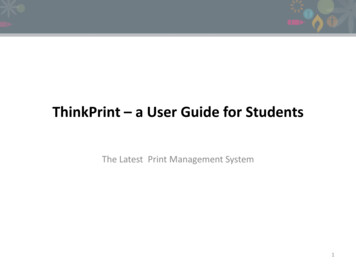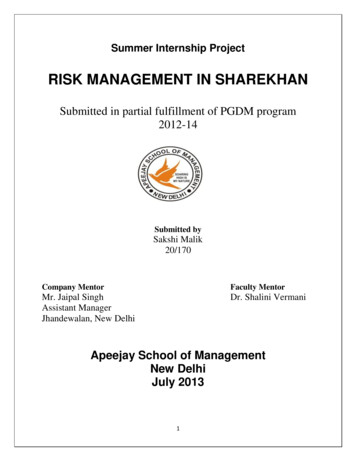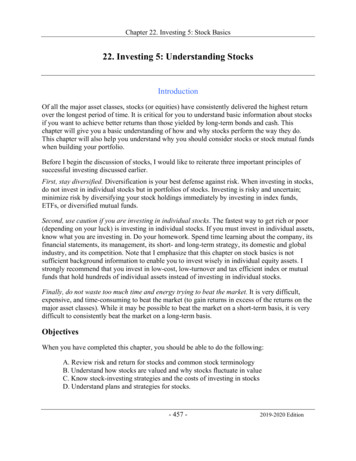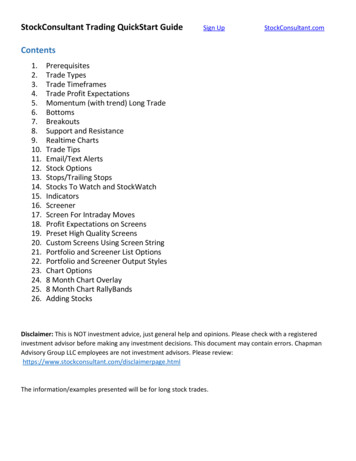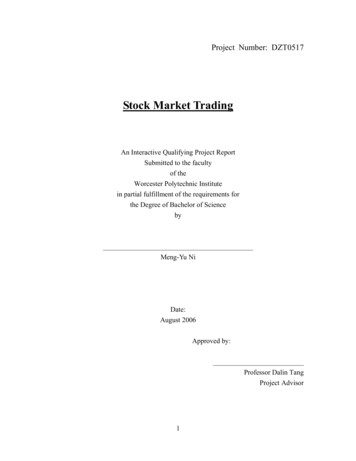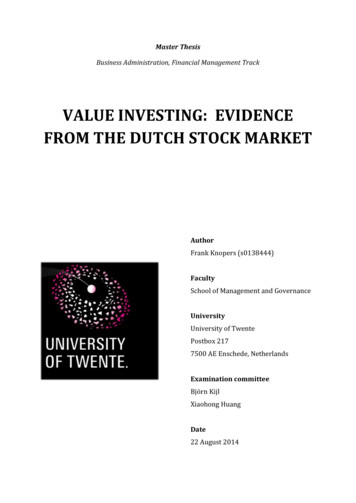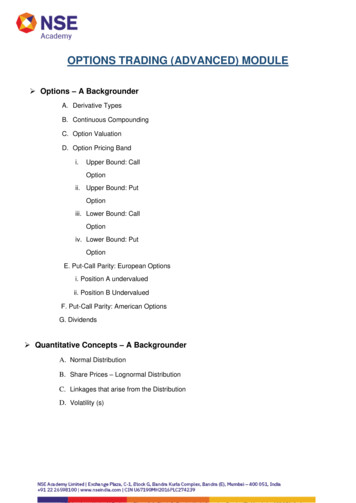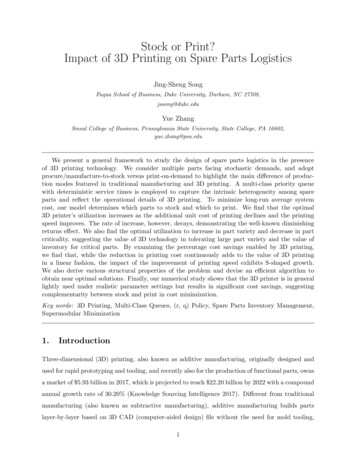
Transcription
Stock or Print?Impact of 3D Printing on Spare Parts LogisticsJing-Sheng SongFuqua School of Business, Duke University, Durham, NC 27708,jssong@duke.eduYue ZhangSmeal College of Business, Pennsylvania State University, State College, PA 16802,yue.zhang@psu.eduWe present a general framework to study the design of spare parts logistics in the presenceof 3D printing technology. We consider multiple parts facing stochastic demands, and adoptprocure/manufacture-to-stock versus print-on-demand to highlight the main difference of production modes featured in traditional manufacturing and 3D printing. A multi-class priority queuewith deterministic service times is employed to capture the intrinsic heterogeneity among spareparts and reflect the operational details of 3D printing. To minimize long-run average systemcost, our model determines which parts to stock and which to print. We find that the optimal3D printer’s utilization increases as the additional unit cost of printing declines and the printingspeed improves. The rate of increase, however, decays, demonstrating the well-known diminishingreturns effect. We also find the optimal utilization to increase in part variety and decrease in partcriticality, suggesting the value of 3D technology in tolerating large part variety and the value ofinventory for critical parts. By examining the percentage cost savings enabled by 3D printing,we find that, while the reduction in printing cost continuously adds to the value of 3D printingin a linear fashion, the impact of the improvement of printing speed exhibits S-shaped growth.We also derive various structural properties of the problem and devise an efficient algorithm toobtain near optimal solutions. Finally, our numerical study shows that the 3D printer is in generallightly used under realistic parameter settings but results in significant cost savings, suggestingcomplementarity between stock and print in cost minimization.Key words: 3D Printing, Multi-Class Queues, (r, q) Policy, Spare Parts Inventory Management,Supermodular Minimization1.IntroductionThree-dimensional (3D) printing, also known as additive manufacturing, originally designed andused for rapid prototyping and tooling, and recently also for the production of functional parts, ownsa market of 5.93 billion in 2017, which is projected to reach 22.20 billion by 2022 with a compoundannual growth rate of 30.20% (Knowledge Sourcing Intelligence 2017). Different from traditionalmanufacturing (also known as subtractive manufacturing), additive manufacturing builds partslayer-by-layer based on 3D CAD (computer-aided design) file without the need for mold tooling,1
jigs, fixtures or cutting tools. Due to its flexibility in small scale production and high customizationcapabilities, 3D printing has been predicted as one of the disruptive technologies to impact theglobal economy and supply chain management by 2025 (Manyika et al. 2013, Janssen et al. 2014).Among the many industries that 3D printing may influence, the spare parts business appears tobe particularly relevant and promising. The manufacturing, storing, and transporting of spare partshas long been a time-consuming and costly task for spare parts suppliers. Maintaining inventoriesof infrequently ordered parts is so expensive that companies are often tempted to stop offeringthem. 3D printing is one potential solution. According to an in-depth survey of 38 major suppliersand buyers of spare parts in Germany by Strategy& in 2015 (Geissbauer et. al. 2017),“this additive manufacturing technology, long used in the prototyping of new products, will enable suppliers to make and send parts on an on-demand basis – and do so locally, close to where the parts are needed. [R]espondents were in agreement that 3D printing will play a major role in the spare parts business.However, not all were aware of the full benefits to be gained from 3D printing.”3D printing spare parts on an on-demand basis can eliminate the parts inventory. However,there are concerns from practitioners as well, which mostly center around three issues: cost how 3D printing impacts the cost formula, given that traditional manufacturing usually enjoyseconomies of scale; speed - the printing time of current 3D printers (varies from hours to a couple ofdays) is far from negligible, therefore it plays an important role in the trade-off between immediateavailability from inventory and waiting to be printed on demand; quality - whether the 3D printedparts have comparable quality to those traditionally manufactured. Last but not least, the answersto these concerns inevitably vary among different parts, given the inherent heterogeneity in theirspecifications and criticality, as well as the capacitated nature of a 3D printer.Our paper aims to provide a mathematical model that explicitly captures the dynamics of the3D printing process, addresses the aforementioned issues and provides managers handy tools anddeeper understandings on spare parts logistics planning when 3D printing is feasible. Specifically,we devise a model that helps decide, to offer the replacement service of multiple parts, whether touse traditional manufacturing to supply part inventory in anticipation of demand or to 3D printon demand. We want to understand how part dependent factors, such as printing time, criticality,demand frequency, etc., influence the optimal decision.We leverage our consulting experience with a global high voltage equipment manufacturer tomotivate the construction of the model, although the model itself is applicable to rather generalsettings (See §3 for details). The global manufacturer we worked with plans to enter an emerging2
market, where the potential customers are utility firms. To serve the new market, one big issueis how to supply service parts after equipment installations. The equipment typically consists ofmany parts, for example, one type of transformer consists of 36 major molded parts. When a partis broken or worn out, the equipment could stop working or underperform and hence needs a partreplacement service.A typical way of supplying service parts is to hold spare parts inventory locally. Using thisapproach, the company needs to procure parts from its long-term supplier located overseas, whoowns traditional manufacturing facilities. Due to geographic distance, the orders placed with thesupplier require a long lead time (one to two months) to arrive. Expedited shipping is economicallyunrealistic and considered infeasible. This approach thus implies high inventory costs, especiallygiven that part variety is large and many parts’ inventory are slow-moving due to infrequent demands. To improve the status quo, the company looks into the option of locally 3D printing theparts on demand.The question thus narrows down to whether the manufacturer should stock or print any givenpart. To answer this question, we recognize that each part is associated with a unique set ofparameters, including demand rate (part failure rate), criticality (the cost when a replacement partis not immediately available, causing equipment outage or underperformance), cost and lead timeto procure from the overseas supplier, cost and time to 3D print, etc. If a part is procured to stock,there are fixed and variable procurement costs, as well as linear inventory holding cost. If the partis printed on demand, printing cost accrues on a per unit basis. The printing time is assumed to bea part-dependent constant to capture the deterministic feature of the printing process (automatedwith minimal labor requirement, see for example, §3.2.6 in Thomas and Gilbert 2014). Given theset of parts to print, the operations at the 3D printer work as a single-server queueing system withmulticlass arrivals.We call the system described above with both the stock option and the print option the hybridsystem; see §3 for details. Two extreme cases are also considered for comparison purposes: thestock system in which all parts are stocked, and the print system in which all parts are printed.We adopt the long-run average system cost as the performance measure. For the hybrid system, apartition decision needs to be made that divides the parts into two exclusive sets: stock or print.The resulting optimization problem is combinatorial and NP-hard.To gain insights on the key determinants of the optimal 3D printer’s usage, in §4 we firstexplore the case when all parts have identical parameters, which we refer to as symmetric parts.This enables us to suppress part heterogeneity and single out the impact of printing technology3
characterized by printing rate and additional unit cost of printing (the difference between unitprinting cost and unit variable procurement cost), and also the impact of part characteristics suchas part variety (i.e., number of parts) and criticality. In this case, our model reduces to a onedimensional convex optimization problem, and we can obtain the optimal solution in closed form(Proposition 1). Moreover, the explicit solution further leads to the following findings. Optimal printer utilization increases as the additional unit cost of printing decliness andthe printing rate improves. But the rate of increase decays, confirming the well-known diminishing returns effect (Corollaries 1 and 2). It is also increasing in part variety and convergesto its upper bound (utilization in the print system), see Proposition 2. It is numerically observed that the optimal printer utilization decreases in part criticality, suggesting the value ofinventory for critical parts in providing immediate availability. However, the decreasing trendweakens very fast as aggregate demand rate decreases or printing speed increases (§4.2). Value of 3D printing, defined as the percentage cost savings enabled by 3D printing, alsoincreases as the additional unit cost of printing declines and the printing rate increases. Whenthe additional unit cost of printing declines to a certain level, the increase becomes linear. Asthe printing rate improves, we numerically observe the increase to be first convex and thenconcave. Therefore, with the future advancement of 3D technology, the reduction of printingcost will continuously add to the value of printing, while the improvement of printing speedwill at first greatly enhance the attractiveness of the technology, but additional speed-ups willhave reduced impact when the printer already has large capacity. In addition, we confirmthe value of 3D printing to be increasing in part variety and numerically observe it to bedecreasing in part criticality.To better understand the structure of optimal partition, we examine various more generalsettings in §5 where the parts share some parameters, i.e., they are partial symmetric parts. A fewnice structures of the optimal partition are identified. In particular, when the parts differ only in printing rate, the optimal partition follows a threshold structure, and can becharacterized by a threshold part index (Proposition 3). To find this threshold, one onlyneeds to examine a few partitions (Proposition 4). Moreover, this structure carries over tonondecreasing demand rates under mild conditions. differ only in demand rate, the optimal partition must belong to the class such that for anygiven aggregate demand for the 3D printer it allocates as many parts to print as possible4
(Proposition 5). This way, the 3D printer is used to cover the robust parts that are infrequently demanded. differ in both printing rate and demand rate, it is cost effective to reduce the printing timeof the more vulnerable part (by investing in, e.g. improving part design or its printingconfiguration), and to improve the quality of the part (i.e., to lower its demand rate) withlonger printing time (Proposition 6). differ only in criticality, we show that the optimal partition may not follow a naturally conjectured threshold policy (Proposition 7).In §6, we study the most general setting where parts can be arbitrarily heterogeneous, with theaim to provide a simple approximate solution. We show that the hybrid system cost, as a functionof the print set (the set of parts to be printed on demand), is supermodular (Proposition 8). Thisenables us to propose a recursive algorithm to obtain a partial optimal partition (§6.1). We furtherdevise a greedy type algorithm that complements the recursive algorithm in finding a heuristic partition (§6.3). The computational complexity of calculating the heuristic is bounded by a quadraticfunction of the number of parts (Proposition 10), demonstrating the heuristic’s computational efficiency. Through extensive numerical experiments with realistic parameter settings in §6.4, we findthe heuristic performs surprisingly well - it attains the optimal partition in all of the 1152 instanceswe examined: in 98.3% of all instances, the recursive algorithm alone leads to the optimal partition,and in the other 1.7% instances, the greedy type algorithm perfectly complements the recursivealgorithm.The numerical results also confirm that 3D technology can yield meaningful and sometimessignificant cost savings across a wide range of model parameters – with a maximum of 43.8% and anaverage of 5.0% cost reduction from the stock system. Moreover, we observe that, under the optimalpartition, the 3D printer’s utilization is relatively low, with an average of 16.2% of its maximalutilization. The combination of cost reductions and low printer usage suggests complementaritybetween stock and print in cost minimization; it also shows that the well documented operationsprinciple of “a little flexibility goes a long way” applies in this context too.Finally, §7 explores multiple extensions of the model and discusses future research directions.All proofs are included in the appendix.5
2.Literature ReviewSpare parts inventory management has been studied extensively in the literature; see reviews byKennedy et al. (2002) and Muckstadt (2005). Many models concern repairable parts and usesystem oriented service constraints such as system availability, expected number of backordersover all spare parts, etc.; Basten and Van Houtum (2014) provide a comprehensive survey. Weconsider replaceable parts as in Kim et al. (2010), who examine the performance-based contractsin restoration outsourcing to mitigate infrequent but high-impact disruptions. We measure itembased inventory level and backorders as well as the expected waiting time in the queue at the3D printer, with the goal to minimize the total system cost. While the majority of the literatureconcern where and how much to stock a single part in multiple locations, we consider multipleparts in a single location. Our focus is on optimal source selection strategy (manufacture/procureto stock v.s. print on demand). Cohen et al. (1992) also study replaceable parts, but with adifferent framework and focus. They consider the inventory management of spare parts with twotypes of demand: customer demand with higher priority and normal replenishment demand withlower priority. With approximate cost functions and service level constraints, they develop greedyheuristic algorithm in solving for the appropriate (s, S) policy for each part’s inventory control.Another related research stream focuses on mass customization as a competitive advantage; Inthis stream, the following two works are most related to ours. Mendelson and Parlakturk (2008)considers a mass producer who carries inventories of a finite set of products by following an (r, q)policy with a positive lead time, and a mass customizer who makes any product configurationto order, modeled as an M/M/1 queue under the FCFS priority rule. Using a duopoly gamethe authors identify conditions under which mass customization is advantageous. Alptekinoglu andCorbett (2010) examine the leadtime-variety tradeoff for a firm in choosing between mass productionand mass customization. They show that unimodal preferences generally result in hybrid productlines, whereas under uniform preferences either all-custom or all-standard product lines are optimal.Although our model share some similarities with this body of literature, the details and focusesare very different. While these works consider product line design with horizontally differentiatedproducts and endogenous demands, we assume a given set of intrinsically different products withexogenous demands. Moreover, we employ a multiclass M/D/1 priority queue to capture productheterogeneity and operational details of mass customization.Our work is related to but different from the literature on MTS (make-to-stock) versus MTO(make-to-order) production for a multiproduct firm, see Arreora-Risa and DeCroix (1998), Dobson6
and Yano (2002), Rajagopalan (2002), Gupta and Benjaafar (2004), Netessine and Taylor (2007),and the references therein. The central issue of these studies is to decide which products to MTS andwhich to MTO in a single production facility (modeled as a single-server queue). Our frameworkis fundamentally different in that the stock or print decision is to be made between an exogenoussource (MTS) and an endogenous source (MTO). While the print option in our model is the sameas MTO, the stock option is not the same as the MTS mode in the aforementioned literature,because the stocked parts are manufactured/procured from an exogenous source, i.e., they do notshare the same facility with the printed parts.To the best of our knowledge, our framework is among the first analytical models to study theimpact of 3D printing in the Operations Management literature. We are aware of only a few otherrecently completed works in this domain. Specifically, Westerweel et al. (2016) examine the impactof additive manufacturing on component design. Through a lifecycle cost analysis, they concludethat component reliability overweighs the component design costs and production costs. Dong etal. (2016) compare the impact of 3D printing and traditional flexible technology on assortmentand capacity decisions. Chen et al. (2017) consider a dual channel retail setting and examinethe impact of 3D printing on product offering, pricing and inventory decisions. Sethuraman etal. (2018) employ game theory to model the product and pricing decisions of firms when personalfabrication (a firm sells products’ design and lets the customers manufacture the product withpersonalized quality using 3D printing) is available. We instead focus on the impact of 3D printingon spare parts logistics design (stock or print) and model the operational details of 3D printingprocess. We do not consider assortment planning or competition, although our modeling of 3Dprinting’s operational details has the potential to aid assortment decisions. We assume the 3Dprinter’s capacity as given, however, the optimal printer utilization obtained from our model shedslight on capacity investment decisions. While most of the above work examine a static model withone selling season, we study a dynamic system with stationary parameters.3.Model and PreliminariesWe consider logistics planning for m types of spare parts, indexed by i M {1, ., m}. Thereplacement demand for one unit of part i arrives according to a Poisson process with rate λi .The demands for different parts are independent of each other. We refer to m as the part variety,Pλ (λ1 , ., λm ) the demand composition, and λM i M λi the aggregate demand rate.Throughout the paper, we use a bold letter to indicate a vector, e.g., x (x1 , ., xm ) (xi ) –7
the dimension of a vector is m unless otherwise specified. We write x i if x1 x2 . xm , andx i if x1 x2 . xm . For any subset A M, we write xA (xi , i A) as the subvector ofx restricted to set A. Let N denote the set of nonnegative integers and R the set of real numbers.Sourcing OptionsThere are two ways to supply any given part i. Stock. The first way is to procure the part from (an) overseas supplier(s) with a continuousrandom lead time Li and keep it in stock locally in anticipation of future demand. We assumethe replenishment lead times for different orders are sequential and exogenous, i.e., the ordersdo not crossover and the lead times have a common distribution (see Chapter 7 of Zipkin2000 for details). For each replenishment order, there is a fixed procurement cost Ki . Theper unit variable procurement cost is c̃i . The per unit holding cost rate is hi . Whenever ademand for part i cannot be met immediately, the demand is backlogged at a unit backordercost rate bi until it is satisfied. Print. The second way is to use a 3D printer to print on demand locally with a deterministicprinting rate µi . The per unit cost associated with printing (including materials cost, pre/postprocessing, machine depreciation, etc. See, for example, Atzeni and Salmi 2012 for detailedassessments) is ĉi . Let ci ĉi c̃i be the additional unit cost of printing. Without loss ofgenerality, we normalize c̃i to be zero unless otherwise specified. Then ĉi ci . Note that cicould be negative, representing printing being cheaper. The per unit waiting cost rate at theprinter is also bi .The system we have described is illustrated in Figure 1. We call it the hybrid system. We say apart parameter of a system is symmetric if all parts share the same value for this parameter. Wesay a system has increasing demand composition if λ i.For ease of presentation, we have leveraged our consulting experience to illustrate the model,however, our model is not restricted to the above interpretations and can be applied to a broad rangeof contexts. For instance, instead of being the transportation lead time from an overseas supplier,Li can also be interpreted as the traditional manufacturing lead time from a local manufacturer.In addition, our model can also be used by spare part suppliers to determine which spare parts tocontinue offering (the stock option), and which are discontinued (the print option). For example,once an antique part is needed, it can be 3D scanned and printed on demand. Therefore, our studysheds lights on the impact of 3D printing on spare parts logistics from a rather general perspective.8
Figure 1: Hybrid SystemObjectives and Decision VariablesOur objective is to minimize the long-run average cost. To achieve this goal, we face two types ofdecisions. First, we need to decide from which source to supply any given part i, i.e., to stock or toprint. This leads to a partition: M S P. For any i, i S means to stock part i by procuringit exclusively from the overseas supplier, and i P means to print part i on demand. In the restof the paper, we will also refer to S (P) as the stock (print) set.Once a partition S P is determined, the second decision to make is how much inventory tostock for the parts in S, which face single stage continuous review inventory systems with backlogsand fixed procurement cost, so the (r, q) policy is optimal here (see Veinott 1965 and Zipkin 2000).Therefore we assume it is adopted for parts in S. Denote the policy as (ri , qi ) for part i and use(rS , qS ) to denote the vector consisting of inventory policies for all parts in S.Let 2M denote the power set of M, then given any P 2M , S is uniquely determined byS M \ P. Hence throughout the paper, we use P as the decision variable representing a partitionunless otherwise specified. There is a slight abuse of notation here, as P is used to both representa set and a partition. To differentiate the contexts, when we mean the partition, we say “partitionP”, and when we mean the set, we simply say “P”. To summarize, the two types of decisionvariables are the partition P 2M , and the inventory policy (rS , qS ) Nm P Nm P . Forsimplicity, we refer to any given pair (P, rS , qS ) as a policy.9
Local InventoryGiven any partition P, following the standard inventory theory (see, e.g., Zipkin 2000, Chapter 6),we have the following facts. Denote Ji (y) as the average inventory holding and backorder cost forpart i S, when a base-stock policy is adopted with base-stock level y. Then it is well known thatJi (y) hi E[(y Di ) ] bi E[(Di y) ],(1)where Di is the lead time demand of part i.The expected long-run average cost for stocking part i under policy (ri , qi ) can be expressed asthe simple average of q base-stock system costs:P i qiqiλi Ki ry rJ (y)λi Ki1 Xi 1 iJi (ri x) .Ci (ri , qi ) qiqiqix 1For any fixed qi , Ci (ri , qi ) is convex in ri . Let ri (qi ) be its smallest minimizer, i.e.,Ci (qi ) min Ci (ri , qi ) and ri (qi ) min{ri Ci (ri , qi ) Ci (qi )}.ri(2)Then, ri (qi ) is the optimal reorder point for the given qi . The optimal order quantity is thusqi arg minqi Ci (qi ) and the optimal reorder point is ri ri (qi ). Let Ci Ci (ri , qi ), which isthe optimal average inventory cost for part i S. For brevity, thereafter we refer to Ci the averagePstocking cost for part i, and i S Ci the total average stocking cost under partition P M \ S.Note that the value of (ri , qi ) is independent of partition, and that it is sufficient to only considerthe policy (P, r S , q S ) for any given P. This enables us to concisely represent a policy by thepartition P.Dynamics at the 3D PrinterThe dynamics at the 3D printer can be viewed as a single server queueing system with multi-classarrivals, where each (type of) part corresponds to a class of arrival. For any given partition P,the arrival process to the 3D printer is thus the superposition of independent Poisson arrivals ofreplacement requests for parts in P, with part i’s demand rate λi . Consequently, the 3D printerworks as an M/D/1 system with multi-class arrivals. In such a system, the classic cµ-rule is theoptimal scheduling rule, with the backorder cost rate bi being the “c” in the cµ-rule, see, e.g., VanMieghem (1995). Formally, we haveLemma 1 For any given partition P, the optimal scheduling rule is to print the waiting jobs withthe highest index bi µi .In the rest of the paper, without loss of generality, we assume the indices in M to be rankedaccording to the decreasing sequence of bi µi , i.e., (bi µi ) i. Also, with the linear cost rate, the10
printing sequence within a class does not affect the system cost. Therefore we assume that withineach class the parts are printed in a first-come-first-served order.The 3D printer’s utilization, as a function of the partition P, is:Xλiρ(P) ρi , where ρi .µi(3)i PTo ensure the queueing system to be stable, we assume the stability condition that the maximumutilization ρ̄ ρ(M) 1. From the theory of priority queues (see, for example, page 440 in Wolff1989), the average waiting time of class i printing job, as a function of the partition P, is:P1j P ρj /µjPPE[Wi (P)] (4) , for i P,2(1 k i,k P ρk )(1 k i,k P ρk ) µiwhere the first term is the average waiting time in the queue and the second is the printing time.The long run average cost of waiting and printing for part i (i.e., class i printing jobs) is thenGi (P) (bi E[Wi (P)] ci ) λi .(5)For brevity, thereafter we refer to Gi (P) as the average printing cost for part i under partition PPand i P Gi (P) the total average printing cost under partition P. Intuitively, the larger P is, themore congested the printer becomes, which will result in higher average printing cost for each partin P. This is confirmed in §4 and §5, and formally stated in Lemma 2(a) of §6.1.The Optimization ProblemTo summarize, for any given partition P, the long-run average cost of the hybrid system isXXCH (P) Ci Gi (P).(6)i Pi M\PThe optimization for the system is then to identify the optimal partitionP argminP 2M CH (P).(7)Let S M \ P . The optimal partition achieves the optimal balance between overall stockingand printing costs across all parts. While the marginal effect of moving one part (say part i) fromstock to print on overall stocking cost is readily given ( Ci ), that effect on increasing the overallprinting cost is more intricate. Lemma 2 and Proposition 8 in §6.1 provide more insights on this.It is worth mentioning two extreme systems, which can serve as benchmark to gain understanding of the value of 3D printing and optimal printer usage:(a) Stock system, in which all parts are to stock. This corresponds to P . By (6), the long runaverage cost of the stock system is given byCS CH ( ) Xi M11Ci .(8)
(b) Print system, in which all parts are to print. This corresponds to P M. By (6), the long runPaverage cost of the print system is CP CH (M) i M Gi (M).Because each of these cases is feasible, we obtain a natural upper bound for the hybrid systemcost: CH (P ) min{CS , CP }.4.Symmetric PartsIn this section, we consider special hybrid systems with all parameters being symmetric acrossparts. The perfect symmetry in parameters enables us to obtain complete characterization of theoptimal partition. This also allows us to suppress the subscripts for all parameters, e.g., λi λ.In this case, ρ̄ mλµand it can be verified that CH (P) (m P )C 2ρ̄m P bρ̄2(1 m P ) bρ̄ P cλ P ,m(9)where the first term in the right hand side of (9) is the total average stocking cost and the restterms are the total average printing cost. Note that ρ(P) P m ρ̄,then by (9), CH can be viewedas a function of ρ: bρ2mC CH (ρ) · b cµ ρ mC .2 1 ρρ̄In this way, we convert the original discrete and combinatorial problem in (7) into a one-dimensionalcontinuous optimization problem. In fact, we can further show convexity of the problem andexplicitly solve for the optimal printer utilization, denoted as ρ . Moreover, we find that a keydeterminant of ρ isC /λ c,b/µwhich is the ratio between the per unit cost of stocking a part (adjusted by the production costψ difference) and the per unit waiting cost of printing a part without any congestion.We can also assess the value of 3D printing by quantifying the percentage cost reduction ofhybrid
3D printer’s utilization increases as the additional unit cost of printing declines and the printing speed improves. The rate of increase, however, decays, demonstrating the well-known diminishing returns e ect. We also nd the optimal uti
